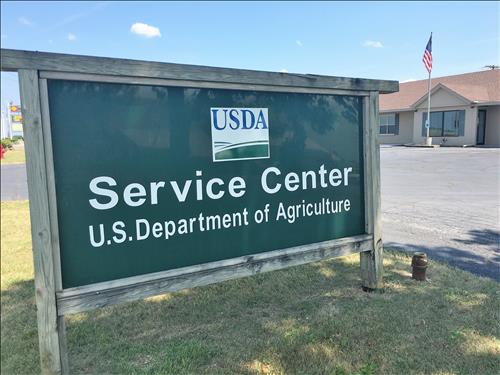
How will the various agencies within the US Department of Agriculture best serve farmers and ranchers in the near term after the Trump Administration has fired thousands of government workers as they plan to slash a significant part of the US government workforce. That includes the NRCS- The Natural Resource Conservation Service.
Specifically- the stakeholders who depend upon the agency are asking that with 1,700 NRCS employees that were terminated in the last few days nationally- which includes 37 employees in Oklahoma- how will conservation programs be delivered effectively?
Sarah Blaney, Executive Director of the Oklahoma Association of Conversation Districts(she also serves as the President of the Association of Conservation Executive Directors), tells the Oklahoma Farm Report that in talking with her peers across the US- it appears that most states have seen 30 to 50 employees terminated in each state.
Blaney tells us “My understanding is that in the state of Oklahoma 37 NRCS employees were fired per the Trump Administration’s request on Friday February 14, 2025. These were across the board cuts that were not based on merit. This directly impacts the ability of remaining NRCS employees to complete their workload and directly affects conservation district employees as a partner of NRCS. My sources are telling me that these cuts were part of a larger nationwide decision where 1,700 NRCS employees were fired and over 290 FSA employees. Farmers and ranchers may be impacted by the reduction in this work force and should plan accordingly. One simple piece of advice for producers would be to make electronic requests of your records from USDA so that you have those on file in case there are further reductions in the workforce.”
Jamey Wood, who worked for NRCS in Oklahoma up until 2023 when he retired, is concerned for those who have been terminated. And Wood has told the Oklahoma Farm Report that he is also concerned about stakeholders who depend upon NRCS to provide the conservation programs that Congress has authorized over the years. He says “The assistance and service that your clientele will receive over the next 10-15 years will be dramatically decreased. Recruiting new employees will be much more difficult without having the job security a federal position normally entails. It was tough enough to compete to get the best and brightest to take a look at positions with the NRCS because we are scattered very thinly across the US and positions in certain locales were not always available. Whenever the NRCS is allowed to hire new employees (which I doubt will be before another 2-3 years) you think the best and brightest will take a chance with a probationary position when an arbitrary decision can be made to wipe out their job at the drop of a hat.”
Nationally- Agri-Pulse has reported on the USDA terminations- including that of the NRCS- “The firings will be a setback for NRCS, which has been trying for years to increase its workforce to help producers implement conservation practices. Many of the impacted staff work in county offices, often serving as farmers’ first points of contact when applying for a federal program, the source said.”
Trey Lam with the Oklahoma Conservation Commission provided this response, “For nearly 90 years, Local Conservation Districts, the Oklahoma Conservation Commission, and the USDA Natural Resources Conservation Service have worked together to provide Oklahomans with soil and water conservation assistance and education. The dust doesn’t blow, flooding is less damaging and the water is cleaner and more plentiful because of this locally led, focused, and voluntary cooperative approach.
When one of the partners is weaker or has fewer resources, however, not only the partnership but Oklahoma in general suffers. The recent terminations of 35 Oklahoma NRCS staff and potentially another 20+ buy-outs may create a huge hole in the conservation delivery system. Challenges such as deteriorating soil health, invasive cedar trees, older flood control dams, frequent drought and flooding along with urban sprawl must be addressed or Oklahomans will pay the price. These terminations have eliminated an entire generation of conservationists who were up for taking on that challenge. Local Conservation Districts and OCC are ready to step up where we can, but we cannot fully fill in the gap with our current capacity.
With the pause in funding for several conservation programs, we understand why farmers’ and ranchers’ trust is dwindling. Many producers who applied for EQIP cost-share assistance are confused because some of them have not yet been paid. This is because these programs were funded through two different pools — The Inflation Reduction Act and the Farm Bill. Practices funded by the Inflation Reduction Act have been paused, while Farm Bill practices are being paid out. Many farmers were not made aware of which pool their application was funded through when they signed up and are now rightfully confused and upset as to why they aren’t receiving their funds after spending tens of thousands of dollars on qualified practices. We hope this trust can be rebuilt and the relationships between producers and conservationists remain strong.
The Oklahoma Conservation Commission hopes to help ease this transition for Oklahomans and provide help wherever we can. We remain committed to the philosophy of leaving our land and water better than how we found it.”
Attributable to a USDA Spokesperson: “Secretary Rollins fully supports President Trump’s directive to optimize government operations, eliminate inefficiencies, and strengthen USDA’s ability to better serve American farmers, ranchers, and the agriculture community. We have a solemn responsibility to be good stewards of Americans’ hard-earned taxpayer dollars and to ensure that every dollar is being spent as effectively as possible to serve the people, not the bureaucracy.
As part of this effort, USDA has released individuals in their probationary period of employment. Secretary Rollins understands the array of mission critical positions and programs at the Department, and she will ensure that those areas have the resources and personnel they need to continue serving the American people.”

















